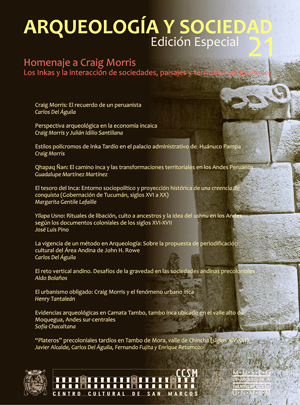ARCHAEOLOGICAL EVIDENCE IN CAMATA TAMBO, TAMBO INCA LOCATED IN UPPER MOQUEGUA VALLEY, ANDES SOUTH-CENTRAL
DOI:
https://doi.org/10.15381/arqueolsoc.2010n21.e12283Keywords:
Camata Tambo, Colesuyo, Inca Way stations, Inca storage, Colcas.Abstract
Archaeological excavations together with paleobotanical analyses conducted in qollqas (Inca storage rooms) at Camata Tambo, an Inca tambo (waystation) located 2,800 m.a.s.l in the upper Moquegua Valley of Southern Peru, suggest that these storage structures incorporated a sophisticated technology designed for storing and controlling multiple types of products from the Colesuyo region including local and distant coastal products. Apparently, this economic surplus based on foodstuffs was later distributed to nearby and far-away populations (e.g. in the altiplano). In addition, although Camata Tambo was in a ‘marginal’ locale of the empire, the site had important political economic functions in the area such as providing valley products to the emerging and more powerful altiplano elites. Further, data collected from excavations conducted at Camata Pueblo, a local community adjacent to the tambo (less than 100 meters), indicate that this community was greatly transformed by the close interactions with imperial infrastructure and bureaucracy that developed through Camata Tambo. The data presented indicate that waystations were institutions that not only provided food and lodging to imperial travelers, but which also had important political economic and administrative imperial roles. Finally, excavations suggest that the operation of these Inca institutions in marginal zones was more ambiguous and ‘open’ than in regions more directly controlled by the empire.Downloads
Published
Issue
Section
License
Copyright (c) 2010 Sofía Chacaltana Cortez

This work is licensed under a Creative Commons Attribution-NonCommercial-ShareAlike 4.0 International License.
THE AUTHORS RETAIN THEIR RIGHTS:
a. The authors retain their trademark and patent rights, and also on any process or procedure described in the article.
b. The authors retain the right to share, copy, distribute, perform and publicly communicate the article published in the Arqueología y Sociedad (for example, place it in an institutional repository or publish it in a book), with an acknowledgment of its initial publication in the Arqueología y Sociedad.
c. The authors retain the right to make a subsequent publication of their work, to use the article or any part of it (for example: a compilation of their works, notes for conferences, thesis, or for a book), provided that they indicate the source. of publication (authors of the work, journal, volume, number and date).






